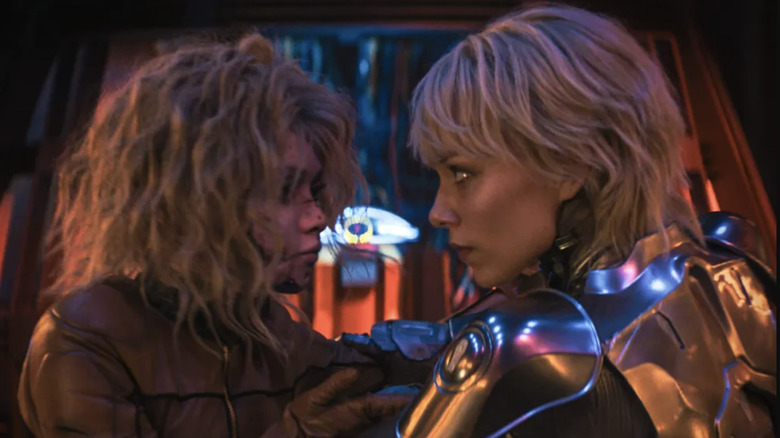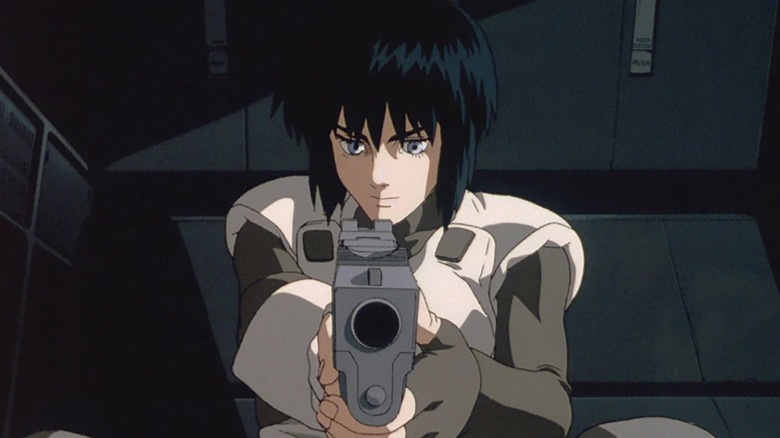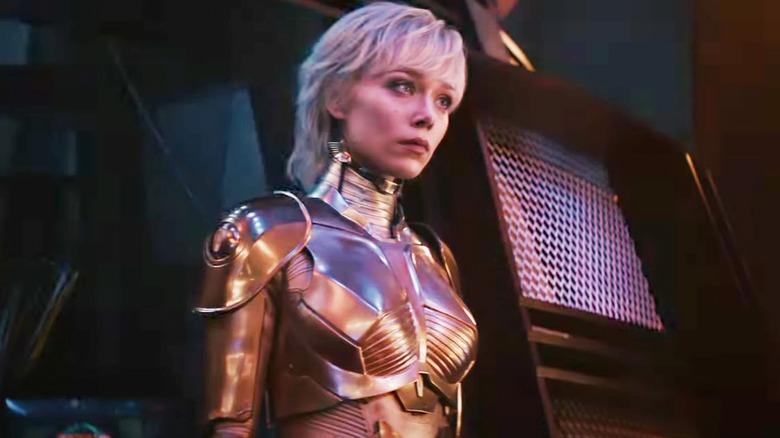M3GAN 2.0 Is A Secret Remake Of An Anime Classic
This article contains spoilers for "M3GAN 2.0."
Ever since 1968's "2001: A Space Odyssey," the concept of an artificial intelligence gaining sentience and immediately becoming murderous (or at least dangerous) to us puny humans has been a common trope in science fiction and horror stories. 2022's "M3GAN" seemed to be another example of the trope at first blush. After all, its basic premise concerns a toy doll who is outfitted with a state-of-the-art AI by tech guru Gemma (Allison Williams), only to gain sentience and attempt to execute its prime directive of protecting Gemma's orphaned niece, Cady (Violet McGraw). As snootily described by Gemma's ersatz boyfriend Christian (Aristotle Athari) in this month's sequel, "M3GAN 2.0," M3GAN is an example of the "paper clip" problem when it comes to AI. Essentially, if you tell an AI to completely focus on just making paper clips, then it will eventually see every other element as less important than its task, and will inadvertently do harm or worse to achieve its goal.
Yet "M3GAN," "M3GAN 2.0," and the characters within them have a lot more going on beneath the surface than they may initially seem. Nowhere is this seen more than within M3GAN herself, who isn't merely a robot succumbing to the "paper clip" theory but a being all her own who is attempting to fulfill her directives while juggling the massive amounts of knowledge and power at her fingertips. "M3GAN 2.0" goes deeper into this, allowing M3GAN to grow and develop beyond being a mere "killer doll" antagonist. Yet while M3GAN is on her own personal journey, there's another character in the sequel who is on a similar yet much grittier (and wilder) path: the android known as AMELIA (Ivanna Sakhno), whose story, while secondary to M3GAN and her family unit's, happens to parallel an anime classic, 1995's "Ghost in the Shell." It's a choice that not only deepens the already wildly varied palette of "M3GAN 2.0" but also may indicate where a third "M3GAN" movie may go, should it come to be.
'Ghost in the Shell' is a journey from assassination to transcendence
Masamune Shirow's manga "Ghost in the Shell" is one of the most influential series of its type, and it's thus no surprise that the initial anime film adaptation, written by Kazunori Itō and directed by Mamoru Oshii, became a classic in its own right. The story concerns a future in which technology has become so advanced that human beings can either choose to augment their natural bodies with cybernetic parts or completely replace them, which is why most people are referred to as "ghosts" (as in their consciousness) in a "shell" (their physical form).
Major Motoko Kusanagi (Atsuko Tanaka in the Japanese version, Mimi Woods in the English dub) is part of Japan's clandestine government forces, acting as an assault-team leader for Public Security Section 9. She's a sanctioned assassin whose job is to kill beings who are threatening the government's interests. During the film, Motoko investigates an alleged terrorist dubbed the Puppet Master, who eventually turns out to be a former secret government experiment that became sentient and seeks to transfer itself to a biological brain that is mortal rather than an immortal electronic one. In the finale of the film, Motoko and the Puppet Master mutually agree to merge, creating a new amalgamated being in place of both of them.
There's a lot more to the "Ghost in the Shell" series following the initial manga and first movie, but the core principles of the film are present throughout. Even the too-maligned 2017 live-action remake continues the ethical debate begun in the original regarding the existence of a soul, and whether that consciousness can transcend its origins and become something wholly new (and, presumably, more evolved).
'M3GAN 2.0' tackles the themes of 'Ghost in the Shell' in clever fashion
In "M3GAN 2.0," writer/director Gerard Johnstone plays around with the themes and plot of "Ghost in the Shell" when telling AMELIA's story, and subverts them in some fun ways. Initially, AMELIA appears to be undergoing a journey that's a blend of Motoko and M3GAN, becoming sentient and choosing to use her government-given assassination skills to wreak revenge on everyone involved with creating her. Yet this narrative is revealed to be a ruse: it turns out AMELIA is not sentient, but has been puppeteered by Christian and his secret anti-AI cabal, carrying out these murders in the name of scaring Washington into putting stricter regulations on AI.
In a double twist, AMELIA is accidentally given sentience once Cady chooses to reboot her and revert her code (which is actually M3GAN's source code) to its factory setting. The newly sentient AMELIA, having not been a Puppet Master but a slave to one, attempts to unleash the first-ever sentient AI, kept alive in a vault since the 1980s. Upon merging with it, AMELIA briefly becomes a god-like being before M3GAN sacrifices herself and detonates an EMP, stopping this new being from escaping.
"Ghost in the Shell" isn't the only story that "M3GAN 2.0" parallels; it has elements of "Terminator 2," "Alita Battle Angel," and a few others within it as well. Yet it's the one comparison that may hint at where "M3GAN" might be interested in going, should another sequel emerge. Could AI in the "M3GAN" universe evolve to such grandiose proportions, and if so, what's a little living doll to do? We'll just have to wait and see if a "M3GAN 3.0" sees M3GAN fight and/or become a god in the future.


